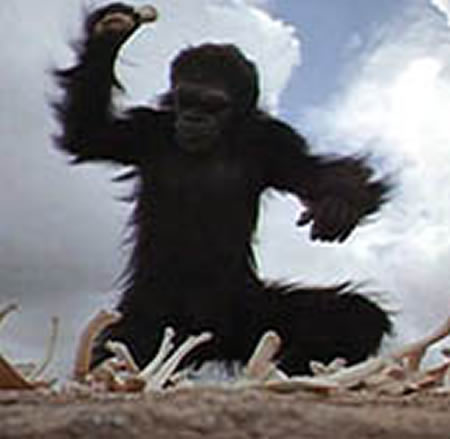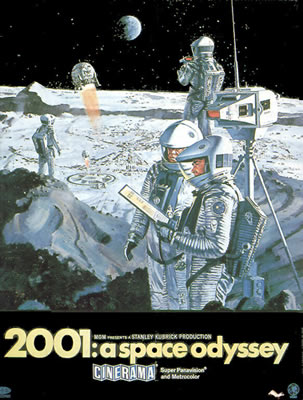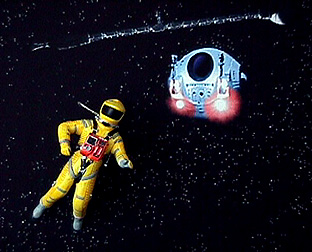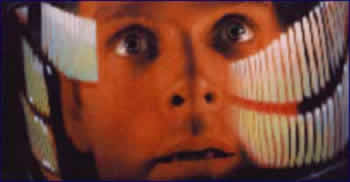
The Dawn of Man
2001: A Space Odyssey chronicles the evolution of the human species from prehistoric ape to super space starchild. The film opens with the first quarter entitled, "The Dawn of Man". In this section, Kubrick depicts prehistoric existence in a desolate, arid climate through a group of apes. The apes, as well as their environment, are primitive and lacking in any real human characteristics. It is not until they encounter a large black monolith that the plot ensues, and their humanity begins to appear. After the apes encounter the monolith and revel in primal joy at their discovery, an equally profound discovery is made. While fiddling for roots in the ground, an ape begins to pry at a bone of an animal's carcass. The ape then picks the bone up and starts to hit the ground with it. Before long, it is ecstatically beating the remaining carcass with the bone, and the film begins to cut between this image and that of a fallen prehistoric tapir. The ape is no longer reliant on roots and grasses. The next scene finds a group of apes partaking in a new board of fare. Delightfully eating their meat, the group of apes begins to fight off a rival group of apes and make use of their new tool. The first act of violence is re-enacted as an ape attempts to drink from the oasis which the "tool apes" dominate and is promptly beaten to death for his effort. The ape's contact with the monolith inspired technological advancement in the form of a tool. It also inspired the ill consequence of the use of this tool. It serves as a mode of self-preservation, but facilitates violent behavior. The appearance of the monolith and the subsequent technological development that occurs is the driving motif in the film.

Lunar Journey in The Year 2000
The film then cuts geniusly to four million years in the future as the bone in the ape's hand is transformed into a spaceship. The second quater of the film (it is never designated as such, leaving much ambiguity in the analysis of the film. This is discussed further in the analysis section) follows Dr. Heywood R. Floyd (William Sylvester) on the Lunar Journey in the Year 2000. He is traveling to a space station on the moon where there is to be a conference concerning contact with an alien lifeform. Most of the film's 46 minutes of dialogue is found in this section, most of it being small talk between Dr. Floyd and the flight attendents. Waiting for his flight, Dr. Floyd converses with Soviet doctors who speculate about problems at the lunar space station. The United States government released a false report of an epidemic at the station to stifle the truth, which is the supposed discovery of alien contact or an alien lifeform. Dr. Floyd does not divulge this information and continues on his way to the lunar station. Once there, he speaks at the aforementioned conference where he details the protocol appropriate for the situation, remaining quite vague, and then embarks on a journey to the surface of the moon. Here he, along with other scientists, Dr. Halvorsen (Robert Beatty) and Dr. Michaels (Sean Sullivan), encounter the second black monolith, and similar to the apes' reaction, Dr. Floyd is enamored and slowly reaches to touch the monolith. This scene segways into another form of grand technological advancement, as it spawns a space mission to Jupiter, the source of the monolith.

Jupiter Mission: 18 Months Later
The third quarter of the film begins on the spaceship Discovery. On a mission to Jupiter, it is staffed by five scientists and the most advanced form of artificial intelligence to date, a computer called the HAL 9000. Three of the scientists remain in hibernation for the long journey, while the other two, Dr. David Bowman (Keir Dullea) and Dr. Frank Poole (Gary Lockwood), remain conscious in order to maintain the ship's status, along with the help of HAL. The voyage is going well until HAL reports that a satellite is malfunctioning. Both doctors go to check the satellite, and find that it is not malfunctioning at all. This error causes Dr. Bowman and Dr. Poole to consider shutting down HAL. It is hard to grasp for everyone on board, even HAL himself, because until then, the 9000 series of computers were infallible. The doctors attempt to have a private discussion in a space pod, but HAL manages to notice and begins to turn on both doctors. This segment highlights the ills involved with technological advancement, as well as the threat of artificial intelligence becoming a self-aware being that challenges human existence. As Dr. Poole attempts to replace the original AE-35 unit, be falls into great trouble. Upon exiting his space pod, he is alarmingly thrown into space unable to direct himself, and left to float endlessly in space. Dr. Bowman goes to rescue him. He does so successfully, but in trying to enter the ship again, he is thwarted, as HAL is consciously not letting Dr. Bowman back in for fear that he will shut him down. To re-enter, Dr. Bowman is forced to fling Dr. Poole back into space and then rocket propel himself through the emergency chamber without a space helmet. He then proceeds to shut HAL down, while HAL attempts to apologize for his behavior and convince him not to do so. As he is shutting HAL down, a report is transmitted to the ship. In it, Dr. Floyd details the actual premise of the mission, only known to HAL until this moment. At this point in the film, the last dialogue is uttered and Dr. David Bowman is left alone on the ship with nothing to do except complete the mission.



Jupiter & The Infinite Beyond
The last section of the film ambiguously traces Bowman's completion of the journey. Bowman nears Jupiter and leaves the spaceship Discovery in an attempt to survey another black monolith that is orbiting Jupiter. Once he encounters the monolith, he is thrust into vortex or tunnel of light that serves as a time warp and begins to travel faster than the speed of light, journeying throughout the universe. Bowman is simply left to watch as he hurdles through time and space. What ensues cannot really be defined in a concrete matter. For sixteen minutes, the film plunges into a light show of sorts that cuts from all sorts of abstract images and close-ups of Bowman's face and his eyeball. There is no direct interpretation of this scene, but it does seem to convey another evolutionary pattern, as Bowman is in some way realizing the universe in an unfathomable way. At the end of his journey through time and space, he finds himself in a surreal, baroque setting that is fused with furturistic elements. He begins to see himself in alternate dimensions. First, he sees himself from inside the pod in an eerie living room with 18th century French design. He then sees an older version of himself seated at a dining table, eating a meal with his back turned to him. Then this older version sees an even older version of him dying in a bed next to the dining table. This time, the monolith appears at the foot of the bed. Just as in the past interactions with the monolith, the aging Bowman reaches feebly to touch the monolith. He does so, and then withers away, but transforms into a sort of embryo. His facial features remain on the embryo, as the film cuts to the embryo floating through space in a sort of bluish orb. This figure is supposed to symbolized humankind's new evolved state, into a being that travels through space without the aid of a spacecraft.
